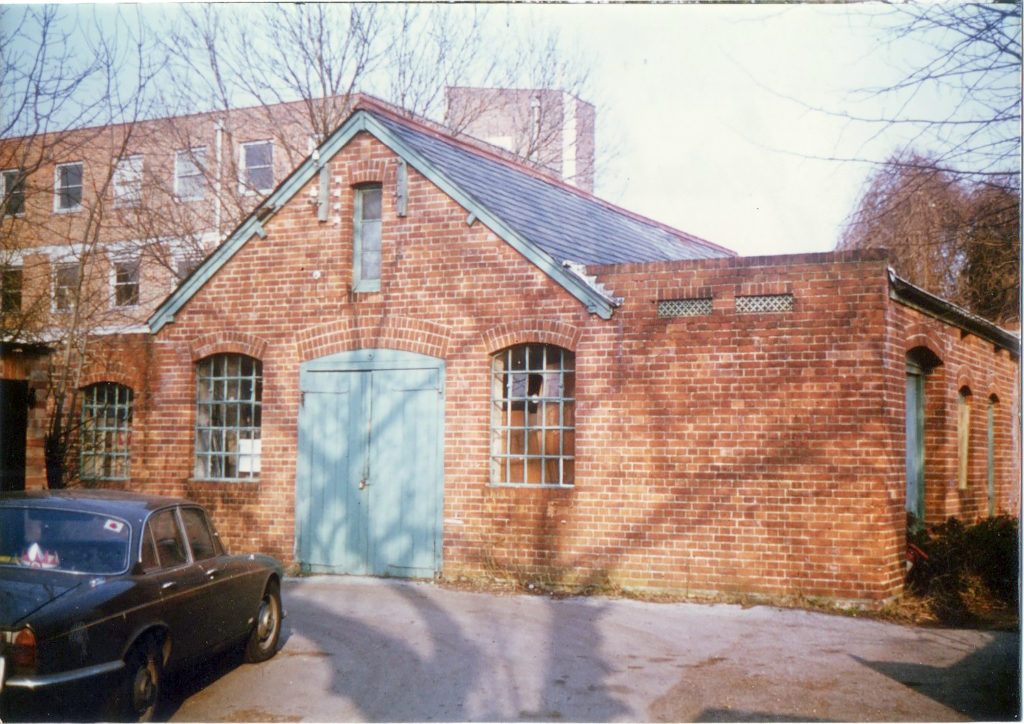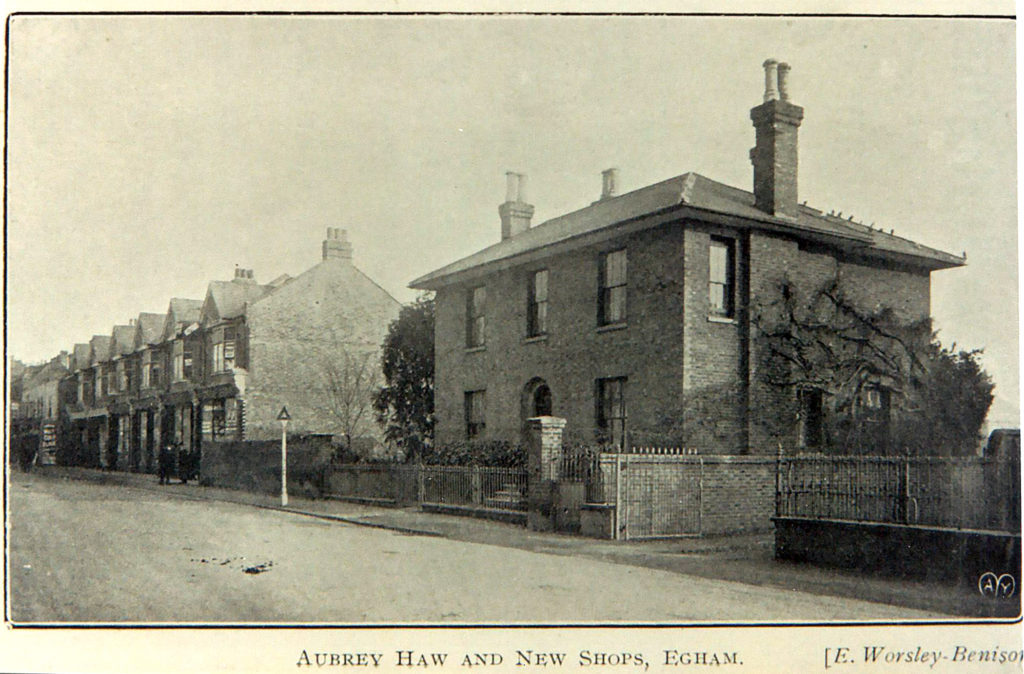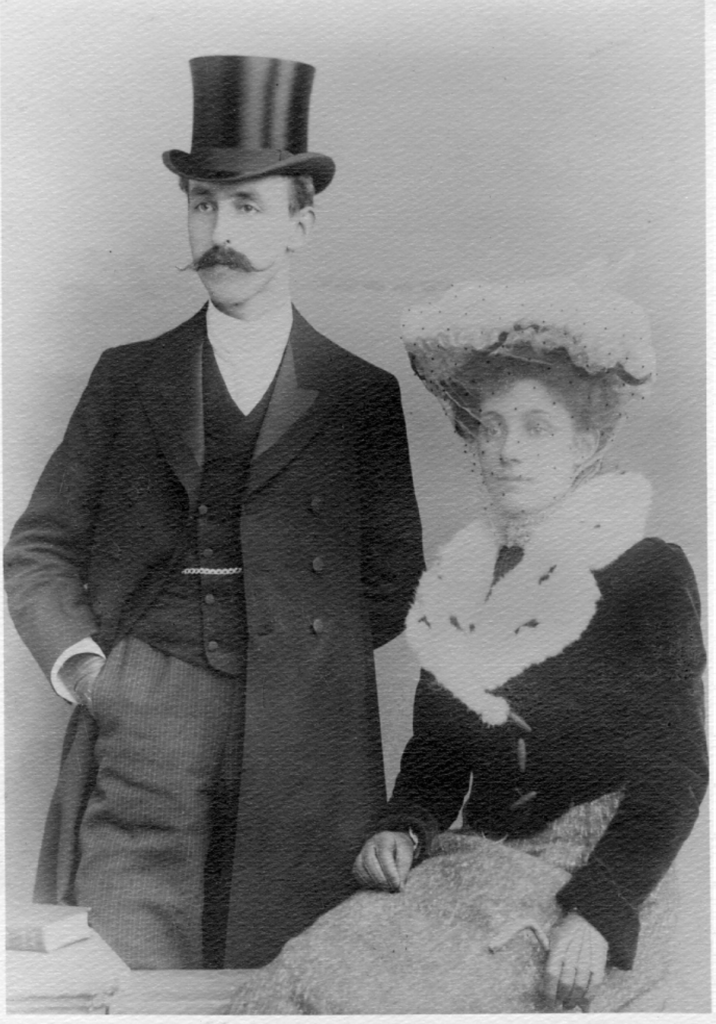Just Williams Part 6 – some of the Victorian tradesmen who shaped Egham High Street
by Margaret C Stewart
6. William Blenheim, electrical engineer 3 Grange Road
Why am I including in this series a William whose business was not based in the High Street? This was a man, credited by his contemporary Rev Tranter Vicar of Egham[i] with being instrumental in the invention of the wireless, telephone and sound amplifiers.
William John Blenheim was born in Englefield Green in 1849, the first child of John Blenheim and his wife Maria (nee Strudwick) and named after John’s older brother, a silk weaver. At the time of William’s birth John Blenheim (1820), originally from Reading, was a plumber and gas fitter on Middle Hill. After young William joined the family business, and it took the name J. Blenheim & Son from about 1874, it became concerned with much more than plumbing. Apparently largely self-taught, they expanded the business to cover all things electrical. At some time between 1851 and 1879 it moved to a larger freehold house with land in St Jude’s Road.
The Post Office directory of 1882 includes an entry for John Blenheim & Son, Telegraph engineers and General contractors, manufacturers of improved electric bells, thief detectors, indicator batteries, gas and water engineers, ironmongers.
Nonetheless in the 1881 Census William described himself as simply a plumber!
In 1877 William married Georgina Starkiss from Little Berkhamsted. The St Jude’s Road property was divided into two separate households for John and Maria, William and Georgina. This was probably a wise move since William and Georgina went on to have seven children: William John Junior (1878-1936), Lilian May (1880-1958), Percy George (1884-1937), Archie Gordon (1885-1896), Daisy Maud Alice (1892-1972), Violet Edith (1894-1957), and Ivy Rose Georgina (1896-?).
The date of John’s death is unclear, but his name no longer appears in electoral registers after 1885. Presumably Maria, who survived until 1890, continued to live alongside her son and daughter in law.
By 1889 William and Georgina had moved to The Terrace, Englefield Green and he began to describe himself as an electrical engineer. From 1890 William rented a workshop in Rusham Road, setting up in his own right as William Blenheim & Co. Ltd, electrical engineers, contractors for electric lighting, patentees for telephone and street fire alarms, telegraphs etc. Apparently William had a simple formula: if he needed something and it didn’t exist, he would invent it.
William Senior had joined the Register of Associates of the Institute of Electrical Engineers in 1893 and shortly afterwards moved to new workshop premises in Grange Road. He lived on site and his family may have moved there with him, but by 1901 they were occupying two Grange Road houses: No 3 for the workshop (where he and his son Percy lived) and No 19 for the family home, occupied at first by Georgina, Lilian and Ivy. The workshop was very well equipped for the manufacture of plumbing and electrical equipment. To power the machinery, he used a gas engine, which was started by a small boy running round inside the flywheel.
He was elected as an Associate Member of the IEE in 1899. In his application he reported that he had been in business as an electrical engineer for about 30 years which would mean that he began at approximately age 20!
His oldest son, William Junior, served an apprenticeship in the company from 1892-5 and stayed on the staff for one additional year. After working briefly for another company, in 1896 he became an Assistant in the Physical Laboratory of the University of Liverpool under Professor Oliver Lodge[ii]. This may have been how William Blenheim Senior was to meet Oliver Lodge and his laboratory assistant Edward Ernest Robinson[iii], with whom he was to collaborate on a series of exciting experiments on the development of radio tuning.
Lodge had a particular interest in the potential of radio waves, inspired by work previously carried out by Tesla and Hertz. In June 1894 he had given a lecture on Hertzian waves[iv] at the Royal Institution. In the audience was Alexander Muirhead [v], scientific adviser to the firm of telegraph engineers founded by his father – Warden, Clark and Muirhead . At Muirhead’s suggestion he and Lodge began to collaborate on devising a reliable system of signalling across space without directing wires.
On 14 August 1894 Lodge succeeded in sending a message of Morse code 150 feet on radio waves between adjacent buildings, during a meeting in Oxford of the British Association for the Advancement of Science. This was a year before Marconi’s initial experiments.
In 1898, Lodge invented a cone loudspeaker, which he referred to as a “bellowing telephone”, that was very similar to the conventional cone loudspeaker drivers that we know today.
In 1901 The Lodge–Muirhead Wireless Syndicate was formed with William Blenheim Junior as Principal Research and Engineering Officer. The syndicate was bought out by Marconi in 1911. Lodge was given an honorific position as ‘scientific adviser.’
Several local and family sources relate that much of the practical work on radio was done at the Blenheim workshop in Egham, and that William Senior and Lodge would carry out experiments on Salisbury Plain, while dressed head to toe in rubber suits. William and Robinson may have made much of the early radio equipment in his workshop. An item in Popular Wireless Weekly from 1924[vi] refers to Sir Oliver’s experimental laboratory at Egham, “where Mr. Robinson is in charge of all the research work undertaken on Sir Oliver’s behalf. “

Apparently, the relationship between Blenheim Senior and Lodge declined because of Lodge’s enthusiasm for spiritualism. He may have brought fellow spiritualist Sir Arthur Conan Doyle to Egham to meet the Blenheims but William declined to join them in a project to try to contact the dead using radio. (Interestingly Lodge’s work in this field inspired American Thomas Edison to look into scientific ways of communicating with the dead.)
William ‘s younger son Percy was to remain associated with his father’s business and continued to live at home until at least 1911. A meeting of the Rural District Council in 1903 agreed with a proposal from “Messrs Blenheim” to lay a main for electric lighting in the High Street and Station Road. Consent was subsequently given by the County Council.[vii]
Suitable land on which to build a power house[viii] became available in 1903 when the large residential property, Aubrey Haw, previously occupied by the Paice family[ix] was put up for auction in a series of separate lots for house and land.
A patch of land at the rear of what is now 164 High Street[x] was purchased on 24 March 1903. Building commenced in 1904 and the resultant brick building with iron framed windows and wooden doors, opened in 1905.

Percy Blenheim and another Egham resident, jeweller Francis Joseph Powell, established the Egham Electric Lighting Syndicate, proposing to supply electric lighting to six adjoining shops to be erected by Powell’s father Francis Sterling Powell, also a jeweller/lapidarist.
The gap between the shops and Aubrey Haw was filled in 1910 by the Gem Cinema (Electric Theatre) –pictured above – also owned by Francis Sterling Powell. Apparently, part of William Blenheim Senior’s remuneration for his involvement in this electrification project was free tickets to the cinema. Whenever he had tickets he could not use, he distributed them to local children making him very popular!
The Egham Electric Lighting Syndicate gave way in 1908 to the Egham & District Electric Light Co. This became the Egham & Staines Electricity Co Ltd in 1911 which built a much larger power station on The Causeway next to Staines & Egham Gas Works. Percy moved to Staines in the 1920s but it is not clear if he was still working with the Electricity Co. The old power house in the High Street was no longer in use by April 1913. Instead it became a workshop and store for the shop at 164 and it survives in that capacity. A new substation was built in Runnymede Road in 1928.
A leaflet distributed circa 1910 advertised an offer from the Egham & District Lighting Co to wire any house free of charge, then provide all necessary lamps, fittings and charging rental for 10 shillings a year per lamp. (This was not cheap: 2023 equivalent is over £75!) The lamps could be used between dusk and dawn or in foggy conditions using electric current provided at no extra charge.
In 1910 William Senior and Georgina set up home in a house called ‘Pembroke’[xi] in Daleham Avenue, a little further away from his Grange Road workshop. But apparently William could work anywhere – if he had an idea during a meal he would doodle on the tablecloth with a pencil, then when the meal was cleared, he would commandeer the cloth and take it to the workshop, never to be returned.
According to Rev Tranter[i] William Senior developed a device which made the telephone practicable. He took this to Edison (in the USA) who incorporated it into his telephone but could not apparently persuade William to join his US company. Tranter also described how William connected an amplifier to his private telephone and using it, with two round holes cut into the door of his workshop, was able to speak to and hear passers-by along Grange Road from his home some distance away. It is said that at one time he had about 300 patents plus many other inventions which he failed to patent. Patents awarded between 1894 and 1914 relate to electric switches, electrical indicators (Egham Museum posesses three of his bell indicator boards https://eghammuseum.org/bell-indicator-board-from-holloway-sanatorium/), electrical current regulators, electric clocks and electric bells.
William Senior died at home in October 1923 and Georgina in 1934 (Percy had moved back to Daleham Avenue in 1933 from his home in Staines, presumably to look after her). He apparently sold the engineering business to GEC who paid him £500 for the residual rights and patents; presumably tablecloths were included! Percy died unmarried in 1937 in Old Windsor, leaving £173 8s 7d to his father’s old colleague Edward Ernest Robinson, retired scientist. Edward Robinson’s sons, Edward and Thomas, had already taken over the offices and workshop at 3 Grange Road in 1922 and ran a printing business there until at least 1939.

Mr K Powley, Mr Charles Oades, Mr R Clarke, Mr Edward Robinson; Front row Mr Thomas Robinson, Mr Heddon, Mr George Edwin Gardener, Mr William Weller, Mr Pitcairn (P952)
William Junior had inherited his father’s love of tinkering with mechanical and electrical engines. In 1900 he became an Associate of the Institute of Electrical Engineers while he was working as an Assistant in the Standardising Department of the Electrical Standardising Testing and Training Institution.
It may not have been clear to outsiders what his job involved so when he married Rosa Pledge from Nuthurst, Sussex in 1903 he described himself as a clerk, although by then he was Principal Research and Engineering Officer, Lodge-Muirhead! Between the years 1904 and 1911 they produced 5 children (Donald Eugene 1904-1990, Enid May 1905 – 1990, Mabel Irene 1907-2008, Vera Grace 1909 – 2004 and Evelyn Beryl 1911 – 2003.)
However, they were to spend much of their married life apart. His work for Muirhead took him to the United States and between 1901 and 1908 he demonstrated the first mobile radio to the Army, made the first ship-to-shore use of radio on the SS Vedamore (inventing an aerial still in use today) and set up the world’s first commercial radio links between Trinidad and the Leeward Islands and also between Rangoon and the Andaman Islands.
Rosa and her children stayed with her parents in Nuthurst when in 1910 he became Superintendent of the Ballinskelleg Cable Station, County Kerry, Ireland, in charge of the whole Atlantic cable system. In 1915 he was appointed Traffic Manager for Western Union[xii] in London and took a house in Wimbledon. This job required him to make frequent visits to New York. From 1918 his UK address was a house called Firlands in London Road Ascot but his job in New York became permanent and he lived at 38 Broad Street NY, with only spasmodic trips home. For some years his children lived with their grandparents in Daleham Avenue. They were enrolled in Miss Spencer’s private school in Grange Road for their early years. The girls then attended a boarding school in Westerham, Kent. Rosa divided her time between New York and her parental home where her daughters joined her after they had finished their education, before moving, one at a time, to New York. William Junior died of a heart attack on 28 Oct 1936 in New York.
His son Donald was one of the first boys to attend the newly re-opened Strodes Grammar School[xiii].

Photo courtesy of Professor Lawence Marsh
After spending much of 1922 ‘learning on the job’ in the Blenheim workshop under the supervision of Robinson & Lodge he became a full time student and went on to achieve a University of London Intermediate B. Sc. Engineering at City and Guilds College in South Kensington[xiv] and he became a student member of the IEE. By 1930 he had followed his father to the US and was working in New Jersey for the American Telephone and Telegraph Company.
William Blenheim Senior’s third son Archie tragically died at age eleven, after falling down stairs and breaking his neck.
As was common at the time, his daughters all married and moved away.
3 Grange Road continued as a trade premises until 1978 when it had to be demolished following a fire; a modern building used for offices occupies the site. The workshop behind was also replaced, with another workshop for repairing cars.
With grateful thanks to Professor Lawrence C Marsh and the rest of William Blenheim’s family who have kindly supplied so many photographs and more stories than there is room to feature here.
General sources: Egham Museum photograph and document collections (including ratebooks), https://www.ancestry.co.uk , https://www.findmypast.co.uk
[i] Tranter, Rev A.C. (n.d.) The Parish Church of St John the Baptist Egham. Gloucester, The British Publishing Co Ltd. Date probably in 1940s. Arthur Cecil Tranter was the vicar of Egham from 1917 until 1947.
[ii] Professor Sir Oliver Lodge (knighted 1902) had his own links to Egham: his brother Alfred was Professor of Mathematics at the Royal Engineering College Cooper’s Hill 1884-1904 and he himself lectured in mathematics and chemistry at Bedford College London ((later merged with Royal Holloway) in the 1870s until his appointment in 1881 as Professor of Physics and mathematics at University College, Liverpool. . Principal of Birmingham University 1900-1919.
[iii] Edward Ernest Robinson had been born in Cork but had family links with Englefield Green.
His parents had moved to Coopers Hill and while living with them in 1881, he was working as a chemist. A decade later he was in Liverpool as a lecture assistant in physics, under Professor Lodge who he later followed to Birmingham University. Eventually Robinson and his family returned to live in Englefield Green at Fernlea, Northcroft Road. He died in 1941.
[iv] Lodge, Oliver (1894) The work of Hertz and some of his successors, being the substance of a lecture delivered at the Royal Institution. Reprinted from The Electrician and revised by Professor Lodge. New York: D van Nostrand Company. https://archive.org/details/workofhertzsomeo00lodguoft/page/n7/mode/2up?view=theater&q=egham [Accessed 22 February 2023]
[v] While studying natural sciences at St Bartholomew’s Hospital in the early 1870s he attached wires to a feverish patient’s wrist to obtain a record of the patient’s heartbeat, possibly the first ever electrocardiogram.
[vi] Popular Wireless Weekly, June 21st, 1924. https://worldradiohistory.com/UK/Popular-Wireless/1924/Popular-Wireless-1924-06-21-S-OCR.pdf [Accessed 22 February 2023]
[vii] The Electric Lighting Act of 1882 had given permission for local authorities to break up streets for the lying of electric mains or authorise private companies to do so. Before this there had been no public supply of electricity and electric lighting was a symbol of wealth restricted to those who could afford to install generating equipment on their own property.
[viii] Bryant, Alan (1994) The old power house, Egham, Surrey. The Ironbridge Institute Diploma Course in Industrial Archaeology, Module 1 Analysing Historic Buildings and Landscapes
[ix] https://eghammuseum.org/just-williams-part-4-some-of-the-victorian-tradesmen-who-shaped-egham-high-street/
[x] Now Dewgard Window Company
[xi] Later owners of the house changed its name to The Magnolias.
[xii] https://atlantic-cable.com/CableCos/WesternUnion/ [Accessed 16/2/2023]
[xiii] He was one of the pioneers of Strode’s Old Boys Association (The Strodian Vol II no 7 July 1924 pp114-116)
[xiv] Part of Imperial College








